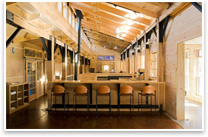 Georgia State Library’s ‘Link’ to BIM Georgia State Library’s ‘Link’ to BIM
Like many great ideas in architecture, the crux of the program for Atlanta’s Georgia State University library renovation, with a glass bridge that spans historic Decatur Street to link two existing university buildings, was sketched out over dinner on a paper napkin. But, aside from just a few more hand-drawn designs, architecture firm Leo A Daly took this project digital and three-dimensional. As the architecture firm’s first fully produced building information modeling (BIM) project, the design process saved time, money, and logistical angst as the building team renewed the old buildings and reorganized the library collections in a way that was least disruptive to Georgia State students and faculty. 
 With Energy Modeling, Virtual Models Lead to Real Sustainability With Energy Modeling, Virtual Models Lead to Real Sustainability
The greenest of the green come with more than a rating and a label, they come with energy modeling
Energy modeling consists of comparing how a proposed building design performs in terms of energy efficiency to a benchmark derived from real or virtual statistics on how energy efficient a comparable conventional building is. This performance measuring tool allows architects and engineers to track how every proposed change to their new design will affect their overall sustainability and energy consumption goals. EnergyStar®, Green Globes™, and LEED® all incorporate energy modeling into their ratings systems differently. 
Copyright or Copy Wrong?
You may know (or think you know) your basic rights and obligations under copyright law. But what misconceptions are commonly held by people you work with, your boss or employees, your clients, or your consultants? You might be surprised. This is the first in a series of articles, by AIA Associate General Counsel Gregory Hancks, AIA, that explores various aspects of copyright that are frequently misunderstood. In this installment, we look at what the Internet has wrought. 
TAKING CARE OF BUSINESS
How Do You Honor Diversity in the Profession? Be Part of the AIA’s Diversity Recognition Program
The AIA Diversity Recognition Program invites program submissions that detail the contributions of AIA members toward the goal of a more diverse profession. Up to 12 submissions will be selected annually to be recognized as Diversity Best Practices. Possible topics for submittals—which must be less than 15 pages long—include a firm-wide focus on creating a diverse practice, proven record of pro bono work for disadvantaged communities or community groups in disadvantaged neighborhoods, creation/support of leadership opportunities for underrepresented groups, programs for maternity leave and paternity leave, sustained support programs for international employees, and many more. Submissions are due September 15. Electronic submissions are preferred and should be sent to diversity@aia.org. Hard copy submissions may be sent to: Diversity Manager Yvette Morris, The American Institute of Architects, 1735 New York Avenue NW, Washington, DC 20006-5292. For submittal requirements and more information, visit the program’s Web site.
|
 Georgia State Library’s ‘Link’ to BIM
Georgia State Library’s ‘Link’ to BIM
 With Energy Modeling, Virtual Models Lead to Real Sustainability
With Energy Modeling, Virtual Models Lead to Real Sustainability